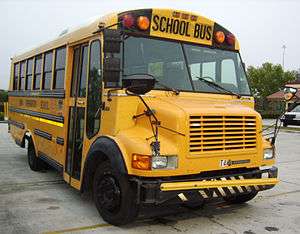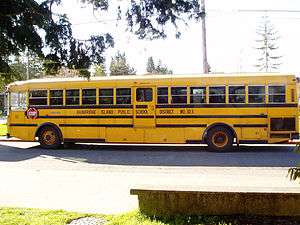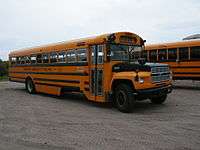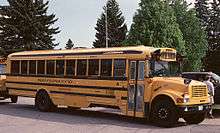Thomas Built Buses
|
| |
| Subsidiary | |
| Industry | Automotive Industry |
| Predecessor | Perley A. Thomas Car Works, Inc. |
| Founded | 1916 |
| Founder | Perley A. Thomas |
| Headquarters | High Point, North Carolina, United States |
Area served | North America |
Key people | Caley Edgerly (President, CEO) |
| Products |
School buses Commercial buses Specialty Vehicles |
Production output | 15,000 vehicles/ year[1] |
| Owner | Daimler AG |
Number of employees | 1,600 |
| Parent | Daimler Trucks North America |
| Website | thomasbus.com |
Thomas Built Buses, Inc. (commonly designated Thomas) is an American bus manufacturer. Headquartered in High Point, North Carolina, the company is a subsidiary of Daimler Trucks North America (the parent company of Freightliner). While best known for its yellow school buses, Thomas also produces, activity buses/MFSAB (Multi-Function School Activity Buses), commercial buses, and bus bodies for aftermarket conversion.
Thomas bus bodies are produced in two facilities in High Point, North Carolina; Thomas also produces the chassis for its Saf-T-Liner/Transit Liner EFX and HDX buses.
History
The oldest surviving bus manufacturer in North America, Thomas Built Buses was founded in 1916. Trained as a woodworker and engineer, Perley A. Thomas had become unemployed as Southern Car Company had closed its doors; the company was a streetcar manufacturer based in High Point, North Carolina. As the city was (and still remains) a center of furniture manufacturing, many workers found jobs in furniture production; Thomas initially founded a company specializing in fireplace mantles and home furnishings.[2]
In the summer of 1916, Thomas Car Works was founded as Perley Thomas began work in modification of existing streetcars in a car barn in High Point.[2] With a $6,000 loan, Thomas purchased the equipment of Southern Car Works at auction, opening a facility in a former ice manufacturing plant. In 1918, the company began production of new streetcars; 25 were produced, leading the company to build its own factory in High Point.[2] Shortly after the company opened, all-steel streetcar bodies joined production of wooden bodies.
1920s: Streetcars
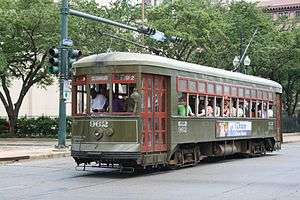
In 1921, the company received its largest order ever, as NOPSI (New Orleans Public Service, Inc.) placed an order for 150 streetcars, to be delivered from 1921 to 1924. As Thomas was unable to fill the order on its own, the company shared a portion of the order with J. G. Brill, based in Philadelphia.[2] In September 1922, after 25 streetcars were delivered, the High Point factory was destroyed by fire.
To keep Thomas Car Works afloat, Perley Thomas secured $100,000 from NOPSI, allowing him to secure parts to build 55 more streetcars, allowing the factory to be rebuilt. By 1928, a third batch of 25 streetcars was delivered, bringing the total produced by the company to 105.[2] While best known from their use in New Orleans, Perley Thomas streetcars would also be utilized by communities across the United States, including Charlotte, NC; Chicago, IL; Detroit, MI; Miami, FL; Mobile, AL; New York City; Philladelphia, PA; Washington, DC, and exported as well, with Havana, Cuba as an user.[2]
In the United States following World War II, the role of streetcars was largely superseded by transit buses. In New Orleans, over 90 years after the construction of the first Perley Thomas 900-series street cars, 35 remain in service (as of 2016) in active daily use in public transportation (on the St. Charles line, the oldest streetcar line in the world).
1930s: Transition to bus construction
In 1930, Thomas Car Works would receive its final order for streetcars, producing 4 for Mobile, Alabama.[2] Although rail-based streetcars offered higher passenger capacity, automotive-based transit buses became more popular as they offered a greater degree of flexibility in route design. In the early 1930s, the company struggled, with most of its business consisting of automotive refinishing andoconstruction of bus and truck bodies.[2] The early 1930s recession hit Thomas Car Works hard, with the company decreased in size from 125 employees to nearly 10 (including Perley Thomas and his three children).[2]
As the 1930s progressed, Thomas Car Works would transition its production away from streetcars. In 1933, the company produced its first trolley bus.[2] In contrast to the electric-powered streetcar, a trolley shared a similar body to a rubber-tired bus; like a streetcar, it drew its power from overhead electric wires. In 1934, the first transit buses built by Thomas were constructed as part of an order for Duke Power of South Carolina.
In 1936, Thomas produced its first school bus. The same year, the company built 200 wooden-bodied school buses for the state of North Carolina,[2] beginning a long tradition with that state which continues to the present day.[1] In 1938, Thomas made a major change to its design as it introduced its first bus body made completely of steel.[2] Although not the first manfucturer to construct an all-steel body, an innovation of the company would later become adopted by all school bus manufacturers. Thomas used roof bows stamped from a single piece of metal (rather than several pieces welded to one another); essentially, the design of the bus allowed the roof to be supported by several internal roll bars welded to each side of the floor.[2] In practice, while the design has been updated for added strength, single-piece roof bows are in use in all school buses manufactured in North America today.
In April 1939, the design of the school bus changed forever as an industry conference led to the adoption of 44 industry-wide safety standards; most of the standards concerned aisle width and seating, but the most notable result of the conference would be the development of school bus yellow as a universal color for school buses in the United States.
1940s: Wartime production
In 1940, day-to-day operation of Thomas Car Works was turned over from Perley Thomas to his three children (though he remained company president). John W. Thomas managed company operations along with sales, along with James Thomas handling the High Point factory.[2] Following the outbreak of World War II, as with its competitors, Thomas bus production was shifted towards the armed forces. In a contract shared with Ward Body Works, Thomas also produced various bodies for the GMC CCKW truck.[2] In a temporary return to the public transit industry, Thomas Car Works supplemented its armed forces contracts by refurbishing streetcars. During World War II, the rationing of materials increased the use of public transportation, leading to the demand for upkeep on existing equipment.[2]
Following World War II, with a rise in student populations, Thomas expanded its sales market beyond the South, opening dealerships in a number of states across the eastern half of the United States.[2] To better weatherproof its entry door, the company developed a reinforced rubber-covered door hinge; the rubber also covered the gap between the two door panels as the closed.[2]
1950s: First Saf-T-Liner
During the mid-1950s, Thomas Car Works introduced the Thomas Saf-T-Liner name as it developed a new windshield design for its bus bodies.[2] During the decade, Thomas would become an internationally based company, establishing manufacturing facilities in Ecuador and Peru; Thomas would ship CKD bodies from North Carolina in CKD form to be constructed on locally sourced chassis.[2]
In 1958, company founder Perley Thomas died at the age of 84, with sons John W. Thomas and James Thomas overseeing the operations of the company.
1960s: A move towards safety
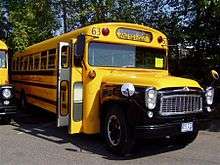
In 1962, Thomas Car Works officially expanded its production beyond High Point as it established a factory in Woodstock, Ontario.[2] At the time, the company became the third-largest producer of school buses in the United States.[2]
For 1969, to reduce blind spots in front of the bus, Thomas introduced a convex blind-spot mirror.[2] In various forms, blind-spot mirrors are currently required on all school buses in North America.
1970s: Thomas Built Buses
In the early 1970s, Thomas underwent a number of major transitions in company leadership and market positioning. In 1972, company president John W. Thomas died, giving leadership to his brother James Thomas, who retired within a year. As the company had moved away from construction of streetcars following World War II, in 1972, company leaders chose a new name for the company tied closer to its current product lines: Perley A. Thomas Car Works became Thomas Built Buses, Inc (a name used in its emblems since the 1950s).[1][2] A third generation of the Thomas family assumed control of the company, with John Thomas, Jr. (President) and Perley Thomas II (VP, international operations).[2]
In the 1970s, Thomas Built Buses began to expand its product lineup beyond the Saf-T-Liner cowled-chassis bus. As an alternative to the Blue Bird All American, Thomas developed the Thomas Saf-T-Liner ER (Engine Rear). As with a number of other manufacturers (Carpenter, Superior, Ward, Wayne), Thomas was dependent on a chassis supplied by another manufacturer for its transit-style school bus (using Ford, Dodge, GMC, International Harvester and Volvo). In 1978, as part of an update to the Saf-T-Liner ER, Thomas made a major change to its design: the introduction of a company-sourced chassis for the ER as well as a front-engine EF (Engine Front) counterpart. Thomas would become the first school bus manufacturer to source chassis for both front and rear-engine models, ahead of Blue Bird by a decade (California manufacturers Crown Coach and Gillig Corporation did not manufacture a front-engine model that competed with Thomas).
1980s: Product diversification
The late 1970s and early 1980s was a period of struggle for all school bus manufacturers. Coupled with the slow economy, manufacturers could no longer count on the factor that had driven school bus sales for the past two decades: the entirety of the baby-boom generation had finished school; it would be years before student populations would create sufficient demand again. During this time, a number of manufacturers either encountered financial difficulty or closed their doors altogether. Thomas diversified its product lineup, entering the small school bus market, creating unique products, and redesigning its transit-style buses to compete with newly introduced competitors.
In the late 1970s, Thomas created its first small bus with the development of the Mighty Mite, a bus paired with the Chevrolet/GMC P30 stripped chassis. Designed as a competitor for the Carpenter Cadet and Blue Bird Mini Bird, the Mighty Mite name was first used as a narrow-body variant of the Saf-T-Liner conventional. In 1980, the Thomas Minotour was introduced. A cutaway-chassis bus, the Minotour was produced on both Ford and General Motors chassis.[2]
The 1980s saw an expansion of the Saf-T-Liner model line, as Thomas introduced the WestCoastER, a heavy-duty variant marketed against Crown and Gillig school buses; in addition to heavier-duty driveline and suspension components, the WestCoastER was also available with tandem rear axles on certain versions. In the late 1980s, the Saf-T-Liner product line adopted the MVP suffix (which stood for Maneuverability, Visibility, and Protection).
In 1989, the Thomas Vista was introduced, adding a second conventional to the Thomas model line. In contrast to the standard Saf-T-Liner conventional, the design of the Vista featured a number of modifications to optimize forward sightlines for drivers. As with a front-engine transit-style bus, the engine was placed next to the driver instead of in front of the driver, shortening the hood length and repositioning the driver seat forward.
Alongside its product changes, during the late 1980s, the corporate structure of the company saw change as well. In order to better compete with other manufacturers, Thomas Built Buses sought to reorganize its management in order to raise capital without having to form partnerships with its own competitors. To do so, the board of directors brought in an investment group (the Odyssey Group) to buy out several shareholders as well as provide the needed capital.[2]
1990s: Acquisition
In 1991, the Saf-T-Liner ER saw its first redesign since 1978, with major improvements on forward visibility. To compete with the Blue Bird TC/2000 and Ward Senator (later AmTran Genesis), Thomas introduced the All Star as a replacement for the Saf-T-Liner EF; the All Star would become the Saf-T-Liner MVP EF/ER in 1994. In 1992, Thomas Built Buses would become operated by a fourth generation of the Thomas family.[2]
In 1996, the company would open a third facility, in Monterrey, Mexico; the same year, Thomas became the largest school bus manufacturer in the United States (by market share).[2]
In 1997, the Thomas Saf-T-Liner FS-65 was introduced, marking the debut of the Freightliner FS-65 chassis.[2] Based on the Freightliner FL60/FL70 medium-duty trucks introduced in 1995, the chassis required several modifications to the Thomas body, including the addition of a 4-piece windshield. With the first completely new bus chassis since 1980, the entry of Freightliner marked the first new chassis producer since Chrysler ended production of Dodge school bus chassis in 1977.
During the late 1990s, to expand its production into segments outside of highway trucks, Freightliner made several acquisitions, including American LaFrance, the chassis products of Oshkosh Corporation, and the rights to the heavy-truck range of Ford Motor Company. In 1998, Freightliner acquired Thomas Built Buses from the Thomas family and the Odyssey Group,[2] marking the third acquisition of a school bus manufacturer acquired by an associated supplier (along with AmTran and Carpenter); the company was the last school bus manufacturer under family control.
2000s: New-generation buses
In 2001, following the closure of Carpenter Industries, Thomas became one of only three builders of full-size school bus bodies in the United States. The same year, its two rear-engine school buses were consolidated into a single product line, marking the debut of the Saf-T-Liner HD (later the HDX). Distinguished by its large mirror assemblies (integrating side-view, convex, and cross-view into a single unit), the HD/HDX visibly utilized Freightliner components in its construction,tincluding its instrument panel and headlights. The corporate alignment between Freightliner and Thomas grew, as the Saf-T-Liner Conventional adopted the FS-65 chassis exclusively for 2003.
In 2004, Perley A. Thomas, founder of the Thomas streetcar and bus building companies, who died in 1958, was among the first inductees into the Raleigh-based North Carolina Transportation Hall of Fame.
A radical change came in 2004 as Thomas marked the introduction of the Thomas Saf-T-Liner C2, based on the Freightliner M2. Designed to mate as a common unit, the C2 marked the first changes to the Thomas full-size bus body in over 30 years. Along with its overall body construction, the Saf-T-Liner C2 was the first conventional-style school bus to adopt the entire dashboard of its donor chassis vehicle. Initially produced alongside the Saf-T-Liner Conventional, the C2 would serve as its replacement. On December 13, 2006, the final Saf-T-Liner FS-65 was produced and delivered to O'Brien Bus Service, Inc. of Maryland.[3]
In 2007, the Saf-T-Liner C2e was introduced, marking the debut of the first hybrid-electric school bus.
In 2009, Thomas launched a second small bus product line. Geared towards the small bus segment,[4] the MyBus uses a modified version of the Minotour body based on Chevrolet/GMC chassis.[5]
2010s: Second century
In 2011, Thomas marked the introduction of the Saf-T-Liner EFX, its first all-new front-engine bus since 1994. Using similar design features as the Saf-T-Liner HDX (its windshield and upper bodywork), the EFX also utilized a center-mounted Freightliner instrument panel.
Although the C2e hybrid was met with little success and was discontinued in 2013, in the early 2010s, Thomas would introduce a number of alternative-fuel vehicles, including CNG and propane variants of the Minotour, and propane and CNG variants of the C2. Since the 1990s, the Saf-T-Liner HDX (as the Saf-T-Liner ER) has been produced with CNG fuel engines as an option.
In the production of its vehicles, during the 2000s and 2010s, Thomas has cleaned the environment, with the company achieving Zero-Waste-to-Landfill status in 2011. For 2012, Thomas was designated a North Carolina Environmental Steward because of its superior environmental performance, commitment to continued reduction of its environmental impact, and demonstrated commitment to exceed compliance regulations.
In 2016, Thomas Built Buses became the first school bus manufacturer to celebrate 100 years of production. Thomas Built Buses is set to launch a new bus on Ford Transit chassis and will begin by spring of 2017.
Products
Thomas Built Buses is a leading manufacturer of Type A, C and D school buses. Thomas Built also produces activity buses,commercial buses, specialty buses and child-care buses derived from the Minotour, Mybus, C2, EFX, and HDX lines.
School Buses
| Current Product Line | |||
|---|---|---|---|
| Model Name | Thomas Minotour/MyBus | Saf-T-Liner C2 | Thomas Saf-T-Liner (EFX, HDX) |
| Photo | 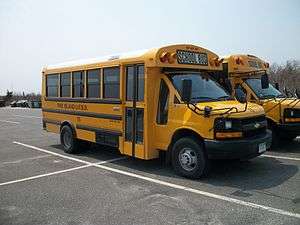 |
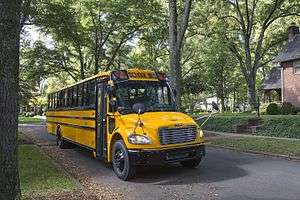 |
 |
| Year Introduced |
|
2004 |
|
| Assembly | High Point, North Carolina | ||
| Configuration |
Type A (cutaway van)
|
Type C (conventional) |
Type D (transit-style) (front engine, rear engine) |
| Chassis Manufacturer |
Ford Motor Company General Motors |
Daimler Trucks North America LLC
|
Thomas Built Buses
|
| Fuel Type(s) |
Minotour
MyBus
|
|
EFX
HDX
|
| Passenger Capacity | 14-30 | up to 81 | up to 90 |
| Other Notes |
Minotour
MyBus
|
|
EFX
HDX
|
| Former Product Lines | |||||
|---|---|---|---|---|---|
| Model Name | Years Produced | Configuration | Chassis Supplier | Notes | |
Mighty Mite  |
mid 1980s-early 1990s | Type B (integrated) |
General Motors
|
| |
Saf-T-Liner Conventional  |
1962-2002 | Type C (Conventional) |
Chrysler Corporation
General Motors
International Harvester Company/Navistar International
|
| |
| Saf-T-Liner FS-65
|
1995–2007 | Type C (Conventional) |
Freightliner
|
| |
| Vista
|
1989-1998 |
Type C (Semi-forward control conventional) |
General Motors (1989-1991) Navistar International (1992-1998) |
| |
| Thomas Saf-T-Liner (EF, ER, WestCoastER)
|
|
Type D (transit-style)
|
Thomas Built Buses |
Saf-T-Liner EF
Saf-T-Liner ER
WestCoastER
| |
| Saf-T-Liner MVP EF/ER, All-Star
|
|
Type D (transit-style)
|
|
All-Star
Saf-T-Liner MVP EF
Saf-T-Liner MVP ER
| |
Other Buses
Thomas sold commercial derivatives of the Minotour, Conventional, Vista, along with the following:[6]

- Transit Liner MVP EF/ER- commercial derivative of Saf-T-Liner MVP school bus
- TL960 - rear-engine transit bus derived from Saf-T-Liner ER[7]
- Chartour- rear-engine transit bus
- CL960 - rear-engine transit bus
- SLF200 (Super Low Floor) series - transit bus jointly developed with Dennis Specialist Vehicles, based on Dennis Dart SLF
| Thomas Built Buses, Inc. Timeline | |||||||||||||||||||||||||||||||||||||||||||||||||
| Bus Type | 1970s | 1980s | 1990s | 2000s | 2010s | ||||||||||||||||||||||||||||||||||||||||||||
| '72 | '73 | '74 | '75 | '76 | '77 | '78 | '79 | '80 | '81 | '82 | '83 | '84 | '85 | '86 | '87 | '88 | '89 | '90 | '91 | '92 | '93 | '94 | '95 | '96 | '97 | '98 | '99 | '00 | '01 | '02 | '03 | '04 | '05 | '06 | '07 | '08 | '09 | '10 | '11 | '12 | '13 | '14 | '15 | '16 | |||||
| Type A | Minotour | ||||||||||||||||||||||||||||||||||||||||||||||||
| MyBus | |||||||||||||||||||||||||||||||||||||||||||||||||
| Type B | Mighty Mite | ||||||||||||||||||||||||||||||||||||||||||||||||
| Type C | Conventional | ||||||||||||||||||||||||||||||||||||||||||||||||
| Thomas/Freightliner FS-65 | |||||||||||||||||||||||||||||||||||||||||||||||||
| Saf-T-Liner C2 | |||||||||||||||||||||||||||||||||||||||||||||||||
| Vista | Vista | ||||||||||||||||||||||||||||||||||||||||||||||||
| Type D | Saf-T-Liner EF/ER | Saf-T-Liner ER | |||||||||||||||||||||||||||||||||||||||||||||||
| Saf-T-Liner MVP EF/Saf-T-Liner EF | Saf-T-Liner EFX | ||||||||||||||||||||||||||||||||||||||||||||||||
| Saf-T-Liner MVP ER | |||||||||||||||||||||||||||||||||||||||||||||||||
| Saf-T-Liner HD | Saf-T-Liner HDX | ||||||||||||||||||||||||||||||||||||||||||||||||
| All Star EF | |||||||||||||||||||||||||||||||||||||||||||||||||
Images
|
See also
References
- 1 2 3 "About Us--Quick Facts". Thomas Built Buses website. Retrieved 2010-04-30.
- 1 2 3 4 5 6 7 8 9 10 11 12 13 14 15 16 17 18 19 20 21 22 23 24 25 26 27 28 29 30 31 "Thomas school bus history,Perley A. Thomas Car Works, Thomas Built Buses, Thomas Built Buses div. of Freightliner, Thomas Built Buses div. of Daimler Trucks, High Point, N.C. - CoachBuilt.com". www.coachbuilt.com. Retrieved 2016-04-21.
- ↑ "Thomas retires the FS-65". Thomasbus.com. 2006-12-13. Retrieved 2010-02-20.
- ↑ "Thomas Built Introduces New Activity Bus". Thomas Built Buses (June 3, 2009). Press release about MyBus. Retrieved 2010-04-30
- ↑ "Our Buses". MyBus website. Retrieved 2010-04-30
- ↑ "Archived Thomas website". Web.archive.org. 1997-04-01. Archived from the original on April 1, 1997. Retrieved 2014-01-04.
- ↑ "comtl96". Web.archive.org. 2000-04-23. Archived from the original on April 23, 2000. Retrieved 2014-01-04.
External links
| Wikimedia Commons has media related to Thomas buses. |

